Australia So Much to See


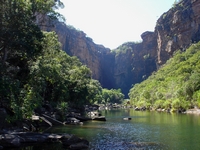
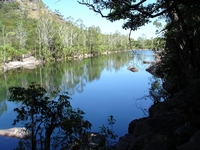
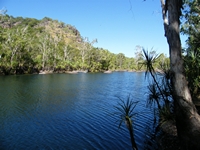
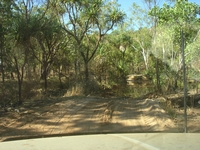
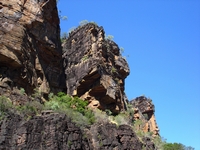
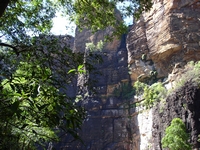
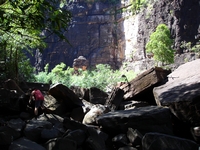
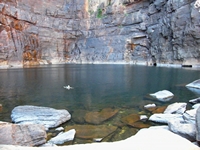
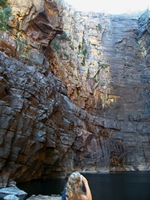
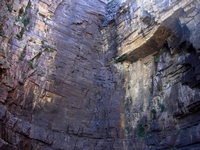
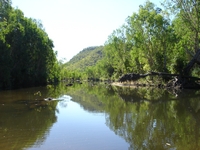
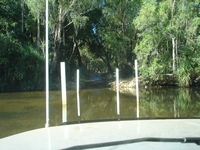
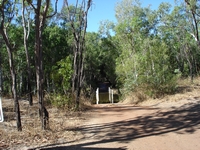
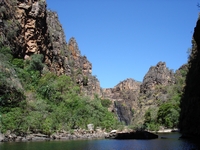
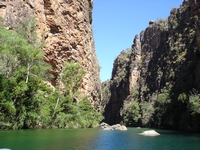
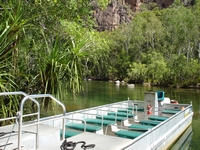
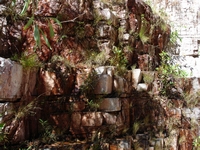
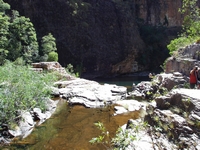
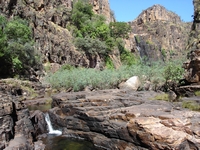
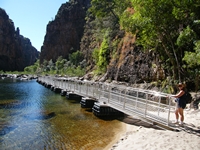
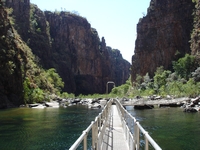
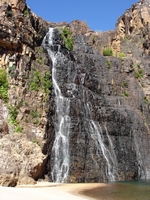
Kakadu National Park - Jim Jim Falls and Twin Falls
Shall we go to Jim Jim Falls?
Jim Jim Falls tumble down from an escarpment of between 200 and 300 metres with a sheer drop of over 150 metres; this time of the
year just oozing over the top. The high walls surrounding the deep plunge pool made a cool and shady environment.
By the time the road is open to get to Jim Jim Falls there is very little water left trickling over the edge at this, the highest
waterfall in Kakadu. Knowing it was not quick and easy to get there, we considered not going. To see these falls at their
spectacular best can only be done by flying over them during the wet season as the road in will be closed.
Discussing the
pros and cons with neighbouring caravanners in the campground, the decision was made. Both parties decided to go the next day,
although our neighbours were unable to make the walk over rough rocks right to Jim Jim Falls due to the lady’s knees.
Starting out early in the morning, we found the first fifty kilometres a good wide dirt road with some corrugated patches. This
road terminates at a gate near the Garnamarr campground from where the narrow track is four wheel drive only, and following the twists
and turns through the trees is slow and hard work. This gate is locked between 8.30 pm and 6.30 am. Many of the trees
have scrapes from the top of the four wheel drive adventure tour coaches that come this way. Driving an F250 with a wheel base
far longer than these coaches was exacting driving. There are also deep sandy patches.
After reaching the car park, there was still a kilometre walk along Jim Jim Creek including scrambling over large boulders to reach
the plunge pool under the falls. As with any streams or pools in areas tourists visit, crocodile traps were in the water. These
are used to monitor for crocodiles.
The last half of the walk was the hardest; finding a way through the large rocks with no defined trail, unless the blood stains on
the rocks from cracks shins were any guide.
There is a further one kilometre walk goes along rocky ledges, with a pontoon bridge over one inaccessible section.
This is a less often visited place than Jim Jim and one not to be missed. We alighted from the boat at a rocky ledge,
where our guide left a small two way radio for us to call when ready to be picked up again.
Back tracking around two kilometres on the access track, the turn off to Twin Falls follows a similar ten kilometre four wheel drive
track, with a concrete causeway deep water crossing at Jim Jim Creek which is open dependent on water levels. There are guide
posts on either side and water level was down to around 400 millimetres deep when we crossed in August 2009. A snorkel
on your vehicle is recommended for this crossing.
There are challenging further walks that can be taken at Jim Jim. The six kilometre return Barrk Malaam Walk takes four
to six hours and involves a steep climb to the escarpment, and is only for fit climbers, with the recommendation to start early in
the morning to avoid overheating. It may be closed late in the season when the temperatures become too hot. Not
something to fit into our day trip. An additional short walk; the one kilometre return Budjimi Lookout Walk leaves from
the car park up onto a rocky outcrop, giving views of the escarpment.
Signage is in place stating not to enter the water downstream of the plunge pool. During the wet season, crocodiles can be found
in most streams and pools within Kakadu.
Prior to the plunge pool is a sandy beach, and a small group of young European travellers had stopped here while some of their group
crossed the creek and took a less rocky path to the plunge pool, where they had swum to the far side under the water trickle.
On reaching the plunge pool, I too swum in the cold water.
In some sections the gorge walls oozed with water and were like a tropical garden with ferns and greenery.
There is also a six kilometre walk from the car park to the top of the falls, which again as a walk to start early in the day. Swimming
above the falls at the top of the scarp is crocodile safe.
After a full on eight and a half hour day, we returned to the campground, weary, but so pleased we decided to go. It was certainly
a day trip well worth taking after all. Our neighbours had arrived back a little before us and he confessed his shoulders were
aching from steering his Landcruiser through the winding tracks. I said mine were too – and I was not the driver! All
the more aches and pains for my husband, handling our long F250 on those narrow tracks twisting between the trees.
Even at the Jim Jim and Twin Falls gorges, we were still near sea level, with the highest point of our drives (distinct from climbs
on walks) within Kakadu being when crossing a hill near the Garnamarr campground, when our dash mounted GPS registered ninety
metres.
After a short walk from the Twin Falls car park, a small boat with a local tour guide costing $12.50 per person is the only permitted
way to travel to the start of the gorge walk into Twin Falls. Swimming is not permitted due to crocodile risk. Prior to
the boat being implemented, visitors used to swim as there was no other way to reach Twin Falls.
As we near the end of the boat ride, we catch a glimpse of water trickling down the cliff face is the distance.
The walk along rocky platforms at the edge of the creek was not difficult, although we were the only ones from that boatload to continue
all the way to the falls.
We arrived at a wide sandy beach at the end of the gorge, where some water was still flowing down the cliff face.
This pontoon bridge is removed for the wet season and set up again for the tourists, being carried into the gorge by helicopter.
We walked back, called our boat man on the two way, assured him there was no-one else in the gorge, and headed back to the car
park. The knowledge that can be gained from these Aboriginal guides alone makes the boat ride worthwhile.
There are overhead sprinklers along the pontoon, and I asked our guide about them during the return on the boat. He replied
that they were used to cool people who were suffering heat stress.
Read more about crocodiles in Australia here
Copyright (C) 2013 AustraliaSoMuchtoSee.com. All rights reserved























